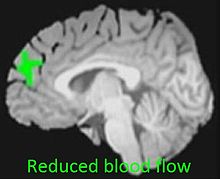| Cannabis use disorder | |
|---|---|
| Other names | Cannabis addiction, marijuana addiction |
 | |
| Reduced blood flow in prefrontal cortex of adolescent cannabis users[1] | |
| Specialty | Addiction medicine, Psychiatry |
| Symptoms | Dependency of THC and withdrawal symptoms upon cessation such as anxiety, irritability, depression, depersonalization, restlessness, insomnia, vivid dreams, gastrointestinal problems, and decreased appetite |
| Risk factors | Adolescence and high-frequency use |
| Treatment | Psychotherapy |
| Medication | None approved, experimental only |
Cannabis use disorder (CUD), also known as cannabis addiction or marijuana addiction, is a psychiatric disorder defined in the fifth revision of the Diagnostic and Statistical Manual of Mental Disorders (DSM-5) and ICD-10 as the continued use of cannabis despite clinically significant impairment.[2][3]
There is a common misconception that cannabis use disorder does not exist.[4][5]
- ^ Jacobus, Joanna; Goldenberg, Diane; Wierenga, Christina E.; Tolentino, Neil J.; Liu, Thomas T.; Tapert, Susan F. (1 August 2012). "Altered cerebral blood flow and neurocognitive correlates in adolescent cannabis users". Psychopharmacology. 222 (4): 675–684. doi:10.1007/s00213-012-2674-4. ISSN 1432-2072. PMC 3510003. PMID 22395430.
- ^ National Institute on Drug Abuse (2014), The Science of Drug Abuse and Addiction: The Basics, archived from the original on 1 April 2022, retrieved 17 March 2016
- ^ Gordon AJ, Conley JW, Gordon JM (December 2013). "Medical consequences of marijuana use: a review of current literature". Current Psychiatry Reports (Review). 15 (12): 419. doi:10.1007/s11920-013-0419-7. PMID 24234874. S2CID 29063282.
- ^ Smith, Dana (10 April 2023). "How Do You Know if You're Addicted to Weed?". The New York Times. Retrieved 24 June 2024.
- ^ MacDonald, Kai (1 April 2016). "Why Not Pot?: A Review of the Brain-based Risks of Cannabis". Innovations in Clinical Neuroscience. 13 (3–4): 13–22. PMC 4911936. PMID 27354924.